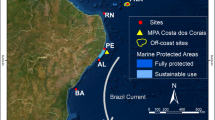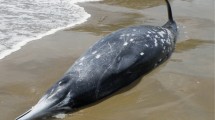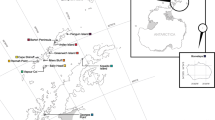Abstract
Delphinid populations show highly variable patterns of genetic diversity and population structure. Previous studies indicate that habitat discontinuities and geographic isolation are major drivers of population division in cetaceans. Spinner dolphins (Stenella longirostris) are distributed in all tropical oceans, but they are particularly common around islands and atolls. This species occurs in shallow waters at daytime to rest and socialise, and feeds on offshore mesopelagic prey overnight. Here, we investigated the genetic population structure of spinner dolphins in the Southwest Indian Ocean along a west–east geographic gradient, from eastern Africa to the Mascarene archipelago. We combined analyses of 12 microsatellite loci, mtDNA control region sequences, and sighting data to assess genetic differentiation and characterise habitat preferences of these populations. Significant genetic structure among the three sampled sites (Zanzibar, Mayotte and La Réunion) was observed using both types of molecular markers. Overall, our results indicate that geographic isolation and potentially other factors, such as shallow-water habitats to rest and socialise, may be important drivers of the genetic population structure of insular spinner dolphins in this region.




Similar content being viewed by others
References
Amir OA, Berggren P, Jiddawi NS (2002) The incidental catch of dolphins in gillnet fisheries in Zanzibar, Tanzania. WIO J Mar Sci 1:155–162
Amir OA, Berggren P, Jiddaw NS (2012) Recent records of marine mammals in Tanzanian waters. J Cetacean Res Manag 12:249–253
Amos B, Schlötterer C, Tautz D (1993) Social structure of pilot whales revealed by analytical DNA profiling. Science 260:670–672
Anderson RC (2005) Observations of cetaceans in the Maldives, 1990–2002. J Cetacean Res Manag 7:119–135
Anderson EC, Dunham KK (2008) The influence of family groups on inferences made with the program structure. Mol Ecol Resour 8:1219–1229
Andrews KR et al (2006) Patterns of genetic diversity of the Hawaiian spinner dolphin (Stenella longirostris). Atoll Res Bull 543:65–73
Andrews KR et al (2010) Rolling stones and stable homes: social structure, habitat diversity and population genetics of the Hawaiian spinner dolphin (Stenella longirostris). Mol Ecol 19:732–748
Aykanat T, Johnston SE, Orell P, Niemelä E, Erkinaro J, Primmer CR (2015) Low but significant genetic differentiation underlies biologically meaningful phenotypic divergence in a large Atlantic salmon population. Mol Ecol 24:5158–5174
Baker C et al (1998) Mitochondrial DNA variation and maternal gene flow among humpback whales of the southern hemisphere. Mar Mamm Sci 14:721–737
Bandelt HJ, Forster P, Rohl A (1999) Median-joining networks for inferring intraspecific phylogenies. Mol Biol Evol 16:37–48
Bérubé M, Jorgensen H, McEwing R, Palsbøll PJ (2000) Polymorphic di-nucleotide microsatellite loci isolated from the humpback whale, Megaptera novaeangliae. Mol Ecol 9:2181–2182
Bird CE, Karl SA, Smouse PE, Toonen RJ (2011) Detecting and measuring genetic differentiation. In: Koenemann S, Held C, Schubart CD (eds) Crustacean issues: phylogeography and population genetics in crustacea, 1st edn. CRC Press, Boca Raton, pp 31–55
Caldwell M, Gaines MS, Hughes CR (2002) Eight polymorphic microsatellite loci for bottlenose dolphin and other cetacean species. Mol Ecol Notes 2:393–395
Christie MR, Johnson DW, Stallings CD, Hixon MA (2010) Self-recruitment and sweepstakes reproduction amid extensive gene flow in a coral-reef fish. Mol Ecol 19:1042–1057
Ciannelli L et al (2010) Small-scale genetic structure in a marine population in relation to water circulation and egg characteristics. Ecology 91(10):2918–2930
Condet M, Dulau-Drouot V (2016) Habitat selection of two island-associated dolphin species from the south-west Indian Ocean. Cont Shelf Res 125:18–27
Cowen RK, Lwiza MMK, Sponaugle S, Paris CB, Olson DB (2000) Connectivity of marine populations: open or closed? Science 287:857–859
Cowen RK, Gawarkiewicz G, Pineda J, Thorrold SR, Werner FE (2007) Population connectivity in marine systems: an overview. Oceanography 20:14–21
Dalebout ML et al (2005) Worldwide structure of mtDNA diversity among Cuvier’s beaked whales (Ziphius cavirostris): implications for threatened populations. Mol Ecol 14:3353–3371
Dolar MLL, Walker WA, Kooyman GL, Perrin WF (2003) Comparative feeding ecology of spinner dolphins (Stenella longirostris) and Fraser’s dolphins (Lagenodelphis hosei) in the Sulu Sea. Mar Mamm Sci 19:1–19
Dulau-Drouot V, Boucaud V, Rota B (2008) Cetacean diversity off La Réunion Island (France). J Mar Biol Assoc UK 88:1263–1272
Evanno G, Regnaut S, Goudet J (2005) Detecting the number of clusters of individuals using the software STRUCTURE: a simulation study. Mol Ecol 14:2611–2620
Excoffier L, Lischer HE (2010) Arlequin suite ver 3.5: a new series of programs to perform population genetics analyses under Linux and Windows. Mol Ecol Resour 10:564–567
Excoffier L, Smouse P, Quattro J (1992) Analysis of molecular variance inferred from metric distances among DNA haplotypes: application to human mitochondrial DNA restriction data. Genetics 131:479–491
Fontaine MC et al (2007) Rise of oceanographic barriers in continuous populations of a cetacean: the genetic structure of harbour porpoises in Old World waters. BMC Biol 5:30
Fullard KJ, Early G, Heide-Jørgensen MP, Bloch D, Rosing-Asvid A, Amos W (2000) Population structure of long-finned pilot whales in the North Atlantic: a correlation with sea surface temperature? Mol Ecol 9:949–958
Gannier A, Petiau E (2006) Environmental variables affecting the residence of spinner dolphins (Stenella longirostris) in the Bay of Tahiti (French Polynesia). Aquat Mamm 32:202–211
Goudet J (1995) FSTAT (version 1.2.): a computer program to calculate F-statistics. J Hered 86:485–486
Guindon S, Gascuel O (2003) A simple, fast, and accurate algorithm to estimate large phylogenies by maximum likelihood. Syst Biol 52:696–704
Hall T (1999) BioEdit: a user-friendly biological sequence alignment editor and analysis program for Windows 95/98/NT. Nucl Acid Ser 41:95–98
Halpern BS et al (2008) A global map of human impact on marine ecosystems. Science 319:948–952
Hoelzel AR (2009) Evolution of population genetic structure in marine mammal species. In: Bertorelle G, Bruford MW, Hauffe HC, Rizzoli A, Vernesi C (eds) Cambridge University Press, New York, pp 294–318
Hoelzel AR, Dahlheim M, Stern SJ (1998) Low genetic variation among killer whales (Orcinus orca) in the eastern North Pacific and genetic differentiation between foraging specialists. J Hered 89:121–128
Holm S (1979) A simple sequentially rejective multiple test procedure. Scand J Stat 6:65–70
Hubisz MJ, Falush D, Stephens M, Pritchard J (2009) Inferring weak population structure with the assistance of sample group information. Mol Ecol Resour 9:1322–1332
Jensen JL, Bohonak AJ, Kelley ST (2005) Isolation by distance, web service. BMC Genetics 6:13. V.3.23 http://ibdws.sdsu.edu/
Jombart T (2008) adegenet: a R package for the multivariate analysis of genetic markers. Bioinformatics 24:1403–1405
Kalinowski ST, Wagner AP, Taper ML (2006) ML-Relate: a computer program for maximum-likelihood estimation of relatedness and relationship. Mol Ecol Notes 6:576–579
Karczmarski L, Würsig B, Gailey G, Larson KW, Vanderlip C (2005) Spinner dolphin in a remote Hawaiian atoll: social grouping and population structure. Behav Ecol 16:675–685
Kiszka J et al (2009) Marine mammal bycatch in the Southwest Indian Ocean: review and need for a comprehensive status assessment. West Indian Ocean J Mar Sci 7:119–136
Kiszka J, Ersts PJ, Ridoux V (2010a) Structure of a toothed cetacean community around a tropical island (Mayotte, Mozambique Channel). Afr J Mar Sci 32(3):543–551
Kiszka J, Simon-Bouhet B, Charlier F, Pusineri C, Ridoux V (2010b) Individual and group behavioural reactions of small delphinids to remote biopsy sampling. Anim Welfare 19:411–417
Kiszka J, Breysse O, Vely M (2010c) Preliminary account of cetacean diversity and humpback whale (Megaptera novaeangliae) group characteristics around the Union of the Comoros (Mozambique Channel). Mammalia 74:51–56
Kiszka J, Simon-Bouhet B, Martinez L, Pusineri C, Richard P, Ridoux V (2011) Ecological niche segregation within a community of sympatric dolphins around a tropical island. Mar Ecol Prog Ser 433:273–288
Knutsen H, Olsen EM, Jorde PE, Espeland SH, André C, Stenseth NC (2011) Are low but statistically significant levels of genetic differentiation in marine fishes ‘biologically meaningful’? A case study of coastal Atlantic cod. Mol Ecol 20:768–783
Krützen M, Valsecchi E, Connor RC, Sherwin WB (2001) Characterization of microsatellite loci in Tursiops aduncus. Mol Ecol Notes 1:170–172
Latch EK, Dharmarajan G, Glaubitz JC, Rhodes OE Jr (2006) Relative performance of Bayesian clustering software for inferring population substructure and individual assignment at low levels of population differentiation. Conserv Genet 7:295–302
Louis M et al (2014a) Ecological opportunities and specializations shaped genetic divergence in a highly mobile marine top predator. Proc R Soc B 281:20141558
Louis M et al (2014b) Habitat-driven population structure of bottlenose dolphins, Tursiops truncatus, in the North-East Atlantic. Mol Ecol 23:857–874
Mannocci L et al (2014) Predicting top predator habitats in the Southwest Indian Ocean. Ecography 37(3):261–278
Martien KK et al (2012) Population structure of island-associated dolphins: evidence from mitochondrial and microsatellite markers for common bottlenose dolphins (Tursiops truncatus) around the main Hawaiian Islands. Mar Mamm Sci 28:E208–E232
Mendez M et al (2011) Molecular ecology meets remote sensing: environmental drivers to population structure of humpback dolphins in the Western Indian Ocean. Heredity 107:349–361
Mendez M et al (2013) Integrating multiple lines of evidence to better understand the evolutionary divergence of humpback dolphins along their entire distribution range: a new dolphin species in Australian waters? Mol Ecol 22:5936–5948
Möller LM, Wiszniewski J, Allen SJ, Beheregaray LB (2007) Habitat type promotes rapid and extremely localised genetic differentiation in dolphins. Mar Freshw Res 58:640–648
Möller LM, Valdez FP, Allen S, Bilgmann K, Corrigan S, Beheregaray LB (2011) Fine-scale genetic structure in short-beaked common dolphins (Delphinus delphis) along the East Australian Current. Mar Biol 158:113–126
Moura AE, Natoli A, Rogan E, Hoelzel AR (2013) Atypical panmixia in a European dolphin species (Delphinus delphis): implications for the evolution of diversity across oceanic boundaries. J Evol Biol 26:63–75
Norris KS, Würsig B, Wells RS, Würsig M (1994) The Hawaiian spinner dolphin. University of California Press, Berkeley, p 408
Oremus M, Poole MM, Steel D, Baker CS (2007) Isolation and interchange among insular spinner dolphin communities in the South Pacific revealed by individual identification and genetic diversity. Mar Ecol Prog Ser 336:275–289
Oremus M, Poole MM, Albertson GR, Baker CS (2012) Pelagic or insular? Genetic differentiation of rough-toothed dolphins in the Society Islands, French Polynesia. J Exp Mar Biol Ecol 423–433:37–46
Palsbøll PJ, Bérubé M, Larsen AH, Jørgensen H (1997) Primers for the amplification of tri- and tetramer microsatellite loci in baleen whales. Mol Ecol 6:893–895
Pante E, Simon-Bouhet B (2013) Marmap: a package for importing, plotting and analyzing bathymetric and topographic data in R. PLoS ONE 8(9):e73051. doi:10.1371/journal.pone.0073051
Peakall R, Smouse PE (2006) GENALEX 6: genetic analysis in Excel. Population genetic software for teaching and research. Mol Ecol Notes 6:288–295
Pelc RA, Warner RR, Gaines SD (2009) Geographical patterns of genetic structure in marine species with contrasting life histories. J Biogeogr 36:1881–1890
Perrin WF (2009) Spinner dolphin Stenella longirostris. In: Perrin WF, Würzig B, Thewissen J (eds) Encyclopedia of Marine Mammals, 2nd edn. Academic Press, San Diego, pp 1100–1103
Perrin WF, Gilpatrick JW Jr (1994) Spinner dolphin Stenella longirostris (Gray, 1828). In: Ridway SH, Harrison R (eds) Handbook of marine mammals. Academic Press, London, pp 99–128
Perrin WF, Warner RR, Fiscus CH, Holtz DB (1973) Stomach content of porpoise, Stenella spp., and yellowfin tuna, Thunnus albacares, in mixed-species aggregations. Fish Bull 71:1077–1092
Perrin WF, Dolar M, Louella L, Robineau D (1999) Spinner dolphins (Stenella longirostris) of the western Pacific and Southeast Asia: pelagic and shallow-water forms. Mar Mamm Sci 15(4):1029–1053
Posada D (2008) jModelTest: phylogenetic model averaging. Mol Biol Evol 25:1253–1256
Pritchard JK, Stephens M, Donnelly P (2000) Inference of population structure using multilocus genotype data. Genetics 155:945–959
Quérouil S et al (2007) High gene flow in oceanic bottlenose dolphins (Tursiops truncatus) of the North Atlantic. Conserv Genet 8:1405–1419
Raymont M, Rousset F (1995) Genepop (version 1.2), population genetics software for exact tests and ecumenicism. J Hered 86:248–249
Razafindrakoto Y, Andrianarivelo N, Cerchio S, Rasoamananto I, Rosenbaum H (2008) Preliminary assessment of cetacean incidental mortality in artisanal fisheries in Anakao, southwestern region of Madagascar. WIO J Mar Sci 7(2):175–184
R Core Team (2015) R: A language and environment for statistical computing. R Foundation for Statistical Computing, Vienna, Austria. URL http://www.R-project.org/
Rosel PE, France SC, Wang JY, Kocher TD (1999) Genetic structure of harbour porpoise Phocoena phocoena populations in the northwest Atlantic based on mitochondrial and nuclear markers. Mol Ecol 8:541–554
Rosenbaum HC (2003) Marine mammals of Madagascar. In: Godman S, Bengston J (eds) The natural history of Madagascar. University of Chicago Press, Chicago, pp 213–216
Rousset F (1997) Genetic differentiation and estimation of gene flow from F-statistics under isolation by distance. Genetics 145:1219–1228
Russello MA, Kirk SL, Frazer KK, Askey PJ (2012) Detection of outlier loci and their utility for fisheries management. Evol Appl 5:39–52
Selkoe KA, Henzler CM, Gaines SD (2008) Seascape genetics and the spatial ecology of marine populations. Fish Fish 9:363–377
Stensland E, Berggren P, Johnstone R, Jiddawi N (1998) Marine mammals in Tanzanian waters: urgent need for status assessment. Ambio 27:771–774
Tamura K, Nei M (1993) Estimation of the number of nucleotide substitutions in the control region of mitochondrial DNA in human and chimpanzees. Mol Biol Evol 10:512–526
Thorne LH et al (2012) Predictive modeling of spinner dolphin (Stenella longirostris) resting habitat in the main Hawaiian Islands. PLoS ONE 7(8):e43167
Valsecchi E, Amos W (1996) Microsatellite markers for the study of cetacean populations. Mol Ecol 5:151–156
van Oosterhoot C, Hutchinson W, Wills D, Shipley P (2004) MICRO-CHECKER: software for identifying and correcting genotyping errors in microsatellite data. Mol Ecol Notes 4:535–538
Veríssimo A, McDowell JR, Graves JE (2011) Population structure of a deep-water squaloid shark, the Portuguese dogfish (Centroscymus coelolepis). ICES J Mar Sci 68:555–563
Viricel A (2012) Using genetics to assess population structure in three cetacean species and to investigate the etiology of cardiomyopathy in Kogia breviceps. Dissertation, University of Louisiana at Lafayette
Viricel A, Rosel PE (2014) Hierarchical population structure and habitat differences in a highly mobile marine species: the Atlantic spotted dolphin. Mol Ecol 23:5018–5035
Webster I, Cockcroft VG, Cadinouche A (2015) Spinner dolphins Stenella longirostris off south-west Mauritius: abundance and residency. Afr J Mar Sci 37(1):115–124
Würsig B, Wells RS, Norris KS, Würsig M (1994) A spinner dolphin’s day. In: Norris KS, Würsig B, Wells RS, Würsig M (eds) The Hawaiian Spinner Dolphin. University of California Press, London, pp 65–102
Acknowledgments
At Mayotte, samples and data from July 2004 to June 2006 were collected during a dolphin research project conducted by the Office National de la Chasse et de la Faune Sauvage (ONCFS, Game and Wildlife Service) and the Agriculture and Forestry Office (Direction de l’Agriculture et de la Forêt). From May 2007 to April 2009, data were collected during a joined programme of the University of La Rochelle, the Office National de la Chasse et de la Faune Sauvage and the Collectivité Départementale de Mayotte. DNA samples were prepared at the Molecular Core Facility at the University of La Rochelle. We would like to thank the Associate Editor and four anonymous reviewers for constructive comments on the manuscript.
Author information
Authors and Affiliations
Corresponding author
Ethics declarations
Conflict of interest
The authors declare that they have no conflict of interest.
Funding
Funding was provided by the Conseil Général de Mayotte, the Ministère de l’Energie, l’Ecologie, le Développement Durable et de la Mer (MEEDDM), the University of La Rochelle and the Office National de la Chasse et de la Faune Sauvage. The samples and data collected in Zanzibar were supported by funding grants from SIDA/Sarec. In Reunion, sampling was co-funded by DEAL-Reunion, BNOI and IRD, as part of the Southwestern Indian Ocean Fisheries Project (SWIOFP).
Ethical approval
All applicable international, national and/or institutional guidelines for the care and use of animals were followed.
Additional information
Responsible Editor: O. Puebla.
Reviewed by Undisclosed experts.
Electronic supplementary material
Below is the link to the electronic supplementary material.
Rights and permissions
About this article
Cite this article
Viricel, A., Simon-Bouhet, B., Ceyrac, L. et al. Habitat availability and geographic isolation as potential drivers of population structure in an oceanic dolphin in the Southwest Indian Ocean. Mar Biol 163, 219 (2016). https://doi.org/10.1007/s00227-016-2999-3
Received:
Accepted:
Published:
DOI: https://doi.org/10.1007/s00227-016-2999-3




